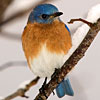 One dull, chilly morning, I looked up from my laptop to see a flutter of blue and red in the living room window of our house in the Berkshires. An American bluebird was snacking on the winterberry branches that I’d tucked among the pine cones and evergreen boughs in the window box. It’s hard to describe the joy I felt at the sight of that bird! But it was pure and unexpected — and happened in a flash. And then, in another flash, it was gone. But the joy has stayed with me in a way that I’ve found puzzling. Had I seen the bluebird of happiness?
One dull, chilly morning, I looked up from my laptop to see a flutter of blue and red in the living room window of our house in the Berkshires. An American bluebird was snacking on the winterberry branches that I’d tucked among the pine cones and evergreen boughs in the window box. It’s hard to describe the joy I felt at the sight of that bird! But it was pure and unexpected — and happened in a flash. And then, in another flash, it was gone. But the joy has stayed with me in a way that I’ve found puzzling. Had I seen the bluebird of happiness?
The myth of the bluebird of happiness actually goes back thousands of years and crops up in cultures across the globe. The bluebird is widely associated with good health and fertility, cheerfulness and prosperity. Native Americans consider it sacred. It’s featured in European plays and Russian fairytales. It is at the heart of our popular culture, as well: “If happy little bluebirds fly away above the rainbow, why can’t I?”
Why it is considered happy, lucky, or a sign of prosperity I can’t say. The day it paid its brief visit was grey and dismal — just another in this long, unrelenting slog of a winter. Perhaps it was just that — the unexpectedness of it — that gave it such power. A splash of bright primary color against the season’s basic black and white. The sudden possibility, going against the litany of February’s cold hard facts, that miracles happen. That spring is coming.

